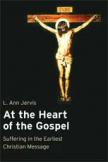Transformed in Gods Embrace
The Bible presents many “explanations” for suffering: punishment for sin, part of the human condition, a test of character, a discipline to make us better persons, an element in God’s mysterious plan and so on. But does the Bible contain a distinctively Christ-centered approach to suffering? L. Ann Jervis, a professor of New Testament at Wycliffe College in Toronto and an Episcopal priest, brings her expertise as a Pauline specialist to this question and explores how Paul treats suffering in 1 Thessalonians, Philippians and Romans. This is a promising choice, because Paul’s letters are the earliest documents in the New Testament and Paul is the most autobiographical of the early Christian writers.
At the Heart of the Gospel invites readers into a conversation with Paul. Jervis wants to show how Paul’s faith in Jesus Christ shapes his reactions to the difficulties of human life (for both believers and nonbelievers) and then to think about how Paul’s response might be ours. In Paul’s Christ-centered approach, our very real sufferings take place in a space embraced by God’s love and are destined to be swallowed by glory.
While Jervis mentions some painful personal experiences of suffering, the focus of her work is the sufferings of Christ, Paul and believers and nonbelievers among Paul’s contemporaries. For each of the three Pauline letters she provides an objective exposition of what Paul says theologically about suffering and then considers how Paul’s response to suffering might be understood or appreciated by us. She describes her approach as more a hermeneutics of sympathy than a hermeneutics of suspicion. She is clearly convinced that Paul has something relevant to say to fellow believers, and she wants us to hear that message and to enter into conversation with Paul.
In 1 Thessalonians Paul challenges fellow believers to recognize that acceptance of the Gospel means acceptance of suffering. The Thessalonians brought to Christian faith by Paul seem to have been experiencing hostility and rejection from their neighbors. While Paul requests that they avoid provoking others, he also stresses that this kind of “affliction” is part of the Christian’s vocation and a necessary prelude to the birth of the new age in which God’s will is done.
In Philippians Paul contemplates, defends and describes suffering as a believer. In this letter from prison, Paul deals with the fact that he is suffering for the Gospel and contends that being “in Christ” does not separate the believer from suffering. Insisting on the cruciform nature of Christian life, Paul appeals to the example of Christ and presents as the Christian ideal being “conformed” to Christ in his suffering and death. He encourages the Philippians to participate in his suffering and to recognize love’s capacity to create communion. Believers who suffer in this context find that life is stronger than death and that God is not absent when they suffer.
In Romans Paul emphasizes that believers share the human lot of suffering, while illuminating the unique context in which they do so “in Christ” and clarifying their obligation to take on additional sufferings “with Christ” for the sake of God’s creation. In reflecting on human suffering Paul personifies sin as the power that causes suffering. While nonbelievers remain imprisoned by sin, those who are “in Christ” remain influenced (but not dominated) by sin and experience the effects of sin in their suffering. Nevertheless, the suffering of those “in Christ” is transformed because it is shaped by God’s loving presence and by hope in God’s future. This in turn can lead to suffering “with Christ” in the sense of sharing Christ’s suffering and suffering for Christ’s sake. This kind of suffering takes place within the horizon of hope for the end of suffering and for the full revelation of God’s glory.
Jervis observes that Paul’s message is hard to hear in the midst of the massive suffering in our world and of the conflicting claims about it. She demonstrates, however, that Paul’s approach is very much Christ-centered. While Paul may use some Stoic terms, in the matter of suffering he is decidedly and unequivocally Christian. The Pauline approach sketched here is not far from the Catholic-mystical approach outlined in Pope John Paul II’s 1984 encyclical Salvifici Doloris.
Paul’s approach to suffering is presented in this volume primarily in a descriptive and objective style. Nevertheless, Jervis is always an engaged reader of the Pauline epistles both as a biblical scholar and as a person of Christian faith struggling with the mystery of suffering in our world and in her life. Her book is very much an exercise in biblical theology, and she shows how dealing with the problem of suffering can illumine all of Paul’s theology. Her analysis of the personification of sin in Romans, for example, puts a new twist on the relation between sin and suffering. It is the cosmic power of sin, not simply my sin that causes suffering. The author shows herself sensitive to the concerns of nonbelievers at every step and is careful to point out possible distortions of Paul’s thinking and their harmful consequences. Just as Paul is best understood as a pastoral theologian, so At the Heart of the Gospel is best viewed as solid pastoral biblical theology. Jervis wisely cautions that suffering “with Christ” is to suffer with the Messiah, not to be the Messiah.
This article also appeared in print, under the headline “Transformed in Gods Embrace,” in the May 21, 2007, issue.








